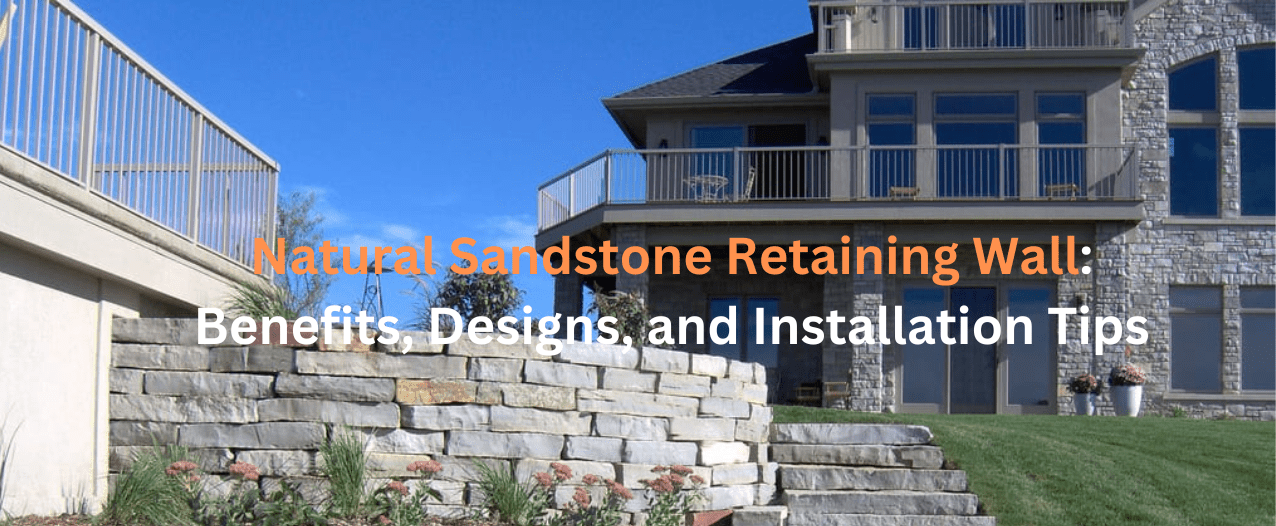It’s truly amazing to find out how small elements like a retaining wall can completely change the overall look of your space. Sandstone installation in your yard can drastically improve the way it looks while serving various benefits like soil stability.
So, let’s identify the advantages of natural sandstone retaining walls throughout this blog post. Here we will explore why this classic material is perfect for your landscaping project.
Benefits of a Natural Sandstone Retaining Wall
Let’s directly come to its benefits. Here are some of them:
Aesthetic Appeal
Its extraordinary beauty is the most obvious advantage of using natural sandstone for retaining wall construction.
With its rough textures and warm, earthy tones, sandstone gives your space an earthy yet refined look. The inherent variation in color and texture makes each natural sandstone retaining wall unique.
Durability and Strength
One of the strongest and most resilient materials for retaining walls is sandstone. Sandstone is extremely resistant to weathering, UV radiation, and freeze-thaw cycles when compared to other forms of stone or man-made materials.
If built correctly, a retaining wall made of natural sandstone can endure for decades without losing its structural integrity.
Eco-Friendly
A natural sandstone retaining wall is a sustainable option if you care about the environment. As a natural resource that doesn’t need to be processed, sandstone has a lower carbon footprint than materials that are made.
Soil Erosion Control
One of the best things about a natural sandstone wall is that it may prevent soil erosion. A retaining wall may help stabilize the soil and prevent it from washing away after heavy rains if your property is on a slope or you have drainage issues.
Increased Property Value
A sandstone retaining wall block enhances your outside space and is a key selling point if you ever decide to put your home for sale. Potential buyers will appreciate the visual beauty and practical benefits of a well-constructed stone wall.
Design Ideas for a Natural Sandstone Retaining Wall
- Traditional Dry Stack Wall Design: The simplicity of dry stack walls makes them suitable for do-it-yourself projects and smaller landscapes.
- Mortared Stone Wall Design: This approach creates a sturdy, long-lasting building by using mortar to hold the stones in place. Where a greater degree of solidity is needed, particularly for taller walls, mortared walls are perfect.
- Terraced Retaining Walls: On sloping estates, terraced retaining walls are an excellent method to make the most of available space. You may break up the slope and give your yard more visual appeal by building walls with several levels.
- Incorporating Planters into the Wall: To contain soil and enable plants to grow straight out of the wall, you can designate areas where the wall is somewhat sunken.
Using Natural Stones for Pathways and Seating
For building rustic outdoor seats or welcoming walks, natural sandstone is a great option. You can make sure that your landscape design feels unified and beautiful by utilizing the same material throughout.
How to Install a Natural Sandstone Retaining Wall
Step 1: Planning and Preparing the Site
You must thoroughly plan and prepare your site before beginning your job. Consider your land’s slope while choosing the location of the retaining wall.
To determine how much stone and other materials you’ll need, measure the space. Verifying that your wall complies with local construction requirements is also crucial.
Step 2: Choosing the Right Sandstone
It’s crucial to choose the appropriate sandstone retaining wall for your project. There are many different colors, textures, and sizes of sandstone, so pick one that complements your style and fits the unique requirements of your wall.
The total strength and longevity of the wall will be impacted by the stone’s thickness and quality, therefore you should also take them into account.
Step 3: Excavation and Foundation Work
The first step is to dig the foundation site. The height of your wall will determine the excavation’s depth.
Digging down at least 4 to 6 inches is necessary to build a sturdy base for most walls. To promote drainage and guarantee the wall’s stability over time, it’s critical to level the base and apply a layer of crushed stone or gravel.
Step 4: Laying the First Course of Stone
Since it will act as the wall’s foundation, the first course of stones is the most crucial. Make sure every stone is level and in the right alignment before placing it. This will guarantee the wall’s durability and stability.
Step 5: Stacking the Stones and Mortaring (if applicable)
Continue piling the stones when the foundation is in place. Just securely connect each stone to create a dry stack wall.
To keep the stones in place when constructing a mortar wall spread a layer of mortar between them. As you proceed, it is essential to check the alignment to make sure the wall stays level and straight.
Step 6: Backfilling and Compacting the Soil
To assist support the construction, backfill the area behind your wall with gravel or soil as you construct it. Make sure the material is packed securely by using a compactor or tamper. In order to keep the wall from moving over time, this step is essential.
Step 7: Final Touches and Maintenance
After the wall is constructed, add any last details, including setting up drainage pipes behind the wall to guarantee enough water flow. Check the wall every few months for routine upkeep, looking for any erosion or fractures.
Common Mistakes to Avoid When Installing a Natural Sandstone Retaining Wall
- Improper Drainage: Inadequate drainage behind your wall might cause water to accumulate and erode the structure.
- Using Low-Quality Stone: Sandstone is not all the same. To guarantee the lifespan of your wall, use a stone of superior quality.
- Skipping the Foundation Layer: A solid foundation is essential to the wall’s stability. If you skip this step, your wall may collapse.
- Incorrect Mortaring: Be careful to apply mortar appropriately if you’re using it. Your wall’s structure may be weakened by improper mortar.
Cost of Building a Natural Sandstone Retaining Wall
The cost of a natural sandstone retaining wall depends on the size of the project, the quality of the stone, and whether you’re building it yourself or hiring an expert.
When factoring up labor and materials, you should budget between $20 and $50 per square foot. This being said, investing in a high-quality wall might increase the value of your house and provide long-term benefits.
Conclusion
A natural sandstone retaining wall would be a beautiful, durable, and eco-friendly addition to any landscape. Maroota Sandstone offers everything you need to make your yard better, from its appearance to its usefulness.
So what are you waiting for? Browse our website and explore various options to make your space more functional and appealing.
FAQ’s
- Is sandstone good for a retaining wall?
Ans: It is true that sandstone is strong, resistant to weather, and gives retaining walls a lovely, organic appearance.
- What is the design procedure for a retaining wall?
Ans: In the design process, the site is evaluated, materials are selected, the layout is planned, and appropriate drainage and foundation support are ensured.
- How to make a sandstone block retaining wall?
Ans: In order to construct a retaining wall out of sandstone blocks, you must first prepare the foundation, then stack the blocks firmly, and make sure that the drainage behind the wall is adequate.
- How long do sandstone retaining walls last?
Ans: Sandstone retaining walls have a lifespan of several decades, sometimes up to fifty years or more, when installed correctly.
- Are sandstone retaining walls expensive?
Ans: Given the price of the stone and installation, sandstone retaining walls can be more costly than other materials, but they provide long-term value.



